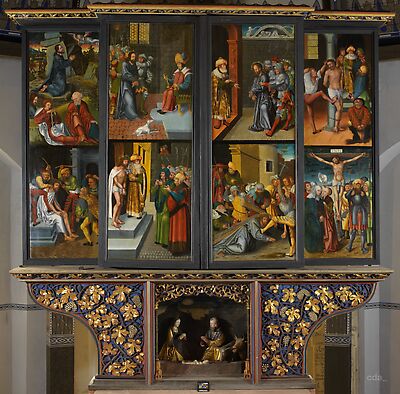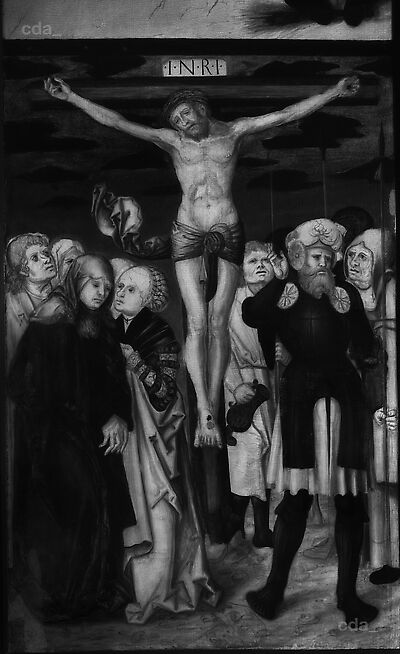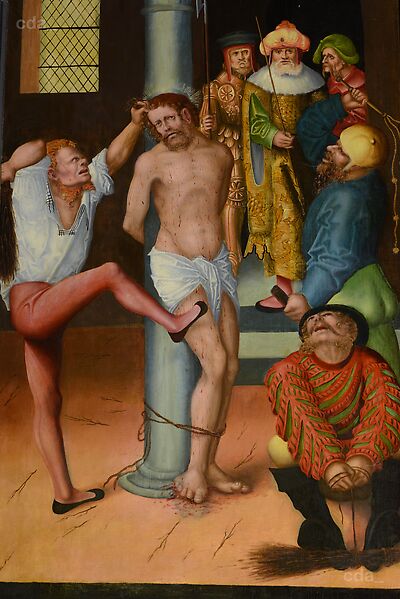- Attribution
- Master of the Döbeln Altarpiece
Attribution
| Master of the Döbeln Altarpiece | Der Gehilfenanteil ist beträchtlich. [with significant assistance] |
- Production date
- about 1519
Production date
| about 1519 | [Lorenz 1856, 7, 100] |
- Dimensions
- Dimensions of support (clear dimension): 267.9 x 80.3 cm
Dimensions
Dimensions of support (clear dimension): 267.9 x 80.3 cm
Dimensions including frame: 269 x 93 cm
[cda 2017]
- Owner
- Friedhofskapelle Heilig Kreuz, Stadt Grimma
- Repository
- Friedhofskapelle Heilig Kreuz, Stadt Grimma
- Location
- Grimma
- CDA ID
- DE_FKG_FKG001I
- FR (1978) Nr.
- FR-none
- Persistent Link
- https://lucascranach.org/en/DE_FKG_FKG001I/
![The Former Highaltar the Church of St Nicolas, Grimma: The Flagellation; The Crucifixion, [right fixed wing, 2nd transformation]](https://lucascranach.org/imageserver-2022/DE_FKG_FKG001I_FR-none/01_Overall/DE_FKG_FKG001I_FR-none_2016-09_Overall-s.jpg)
![The Former Highaltar the Church of St Nicolas, Grimma: Nicolas is made bishop of Myra; The Miracle of the Man run over by a Wagon [left inner wing, 1st transformation]](https://lucascranach.org/imageserver-2022/DE_FKG_FKG001D_FR-none/01_Overall/DE_FKG_FKG001D_FR-none_2016-09_Overall-s.jpg)
![The Former Highaltar the Church of St Nicolas, Grimma: St Nicolas saves the Sailors from the Stormt; A Knight with his Horse before St Nicolas' Altarpiece [right inner wing, 1st transformation]](https://lucascranach.org/imageserver-2022/DE_FKG_FKG001E_FR-none/01_Overall/DE_FKG_FKG001E_FR-none_2016-09_Overall-s.jpg)
![The Former Highaltar the Church of St Nicolas, Grimma: St Nicolas donates gold; St Nicolas as Protector of Pilgrims [interior of outer left wing, 1st transformation]; Christ before Caiaphas; Ecce Homo [exterior of outer left wing, 2nd transformation]](https://lucascranach.org/imageserver-2022/DE_FKG_FKG001F_FR-none/01_Overall/DE_FKG_FKG001F_FR-none_2016-09_Overall-s.jpg)
![The Former Highaltar the Church of St Nicolas, Grimma: the Miracle of the Wheat; The Miracle of the Golden Chalice [interior of outer right wing, 1st transformation]; Christ before Pilate; Christ carrying the Cross [exterior of outer right wing, 2nd transformation]](https://lucascranach.org/imageserver-2022/DE_FKG_FKG001G_FR-none/01_Overall/DE_FKG_FKG001G_FR-none_2016-09_Overall-s.jpg)
![The Former Highaltar the Church of St Nicolas, Grimma: The Arrest of Christ; The Mocking of Christ, [left fixed wing, 2nd transformation]](https://lucascranach.org/imageserver-2022/DE_FKG_FKG001H_FR-none/01_Overall/DE_FKG_FKG001H_FR-none_2016-09_Overall-s.jpg)



